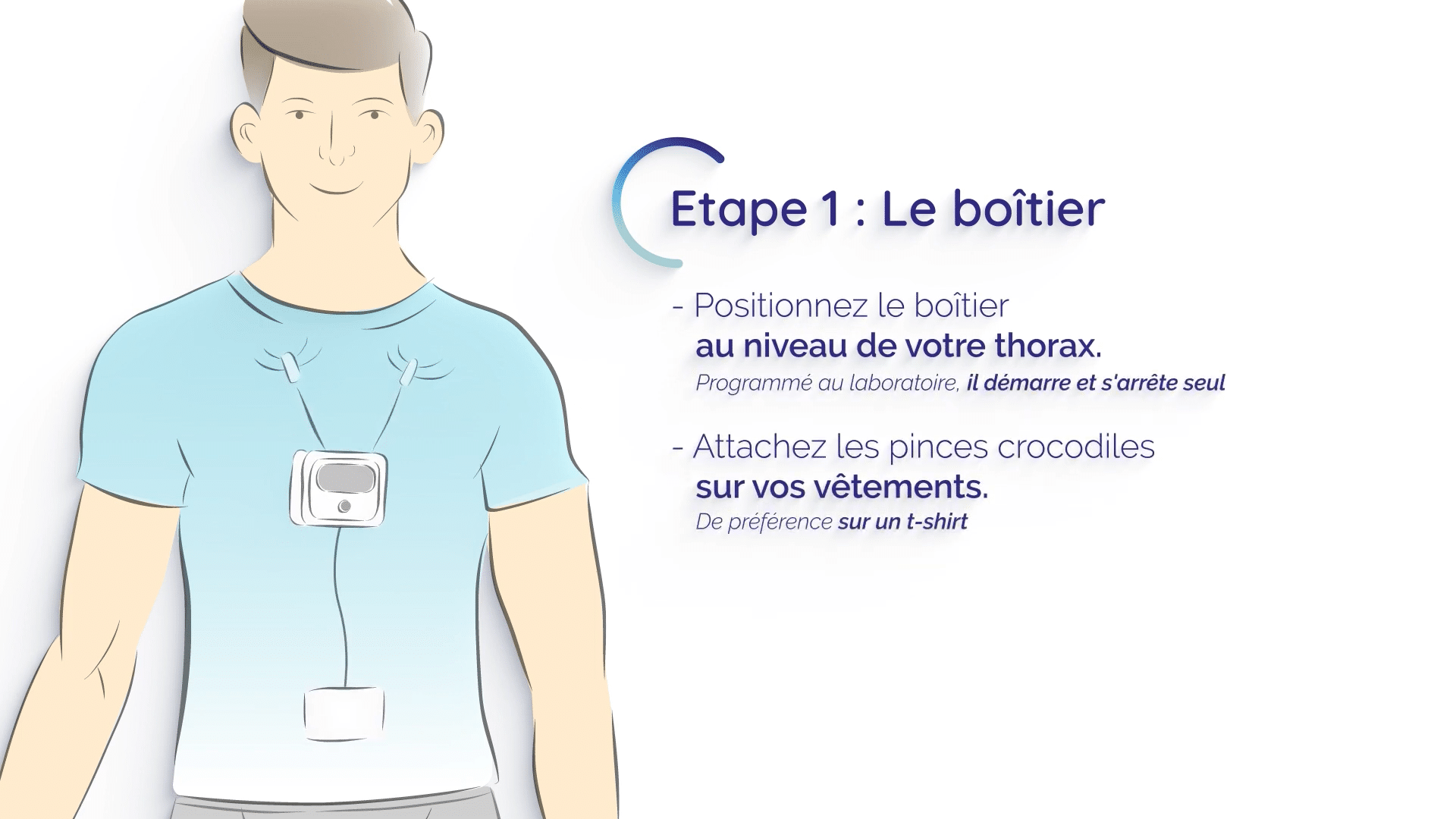Polygraphy equipment
01. The device
Attach the crocodile clips near your collar so the device rests on your chest. Ideally, wear a t-shirt.
02. The straps
Place the two belts around your chest
(under the armpits) and your navel, pass them behind your back, and clip them to each end of the device and the abdominal cable connector.
03. The nasal cannula
Insert the two prongs into your nostrils, place the tube behind your ears and adjust it under your chin. Secure it to your cheeks with the adhesive tape provided. Make sure it is positioned correctly in your nose.
04. The oximeter
Place the oximeter on your non-dominant wrist and insert the sensor onto your index finger all the way to the tip. Secure the
sensor with the adhesive tape. The wire should run over the back of your hand.
The test is carried out at home on an outpatient basis.
Avoid showering after putting on the device.
Follow the bedtime hours agreed with the sleep laboratory.
You can get up during the night.
You can sleep in any position.
Avoid nail polish.
The device is programmed, it will start and stop on its own.
Upon waking, remove the sensors and store the device in the box.
Why perform a nocturnal respiratory polygraphy?
Nocturnal respiratory polygraphy is used to diagnose and/or confirm sleep apnea syndrome (SAHS), which is characterized by repeated breathing pauses during sleep.
This test measures respiratory markers and blood oxygen levels in patients during sleep. In some cases, the results of ventilatory polygraphy cannot be used because sleep has been too fragmented. This makes it impossible to accurately determine the AHI. In such cases, polysomnography is essential.
- Confirm or rule out the diagnosis of OSAHS
- Determine the severity of respiratory disorders
- Identify other sleep disorders
- Refer to the most appropriate treatment
- < 5: no sleep apnea
- Between 5 and 15: mild sleep apnea
- Between 16 and 30: moderate sleep apnea
- > 30: severe sleep apnea syndrome

Home setup of a respiratory polygraphy
Are you preparing to perform a respiratory polygraphy test at home? This video provides all the information you need to perform this sleep test with complete peace of mind.
Nocturnal respiratory polygraphy procedure
Unlike polysomnography, this test is performed at home. The patient equips themselves with two belts (one around the chest and one around the abdomen) to record respiratory movements, a sensor positioned at the base of the neck to record snoring and breathing sounds, an oximeter to measure blood oxygen levels, and a nasal cannula to capture airflow.
The device takes less than 30 minutes to set up. It is easy to use, allowing you to carry out the test at home in comfort, according to your usual routine. The next morning, disconnect the sensors and the recording device and return them to the Cenas center.
FAQ – Respiratory polygraphy and sleep apnea
What are the early signs of sleep apnea?
What’s the difference between polygraphy and polysomnography?
Polygraphy and polysomnography are two tests used to diagnose sleep disorders, but they differ in terms of accuracy and indications.
- Ventilatory polygraphy is a simpler test that can be performed at home. It mainly records respiratory parameters (nasal airflow, chest and abdominal movements, oxygen saturation, snoring). It is recommended for screening for obstructive sleep apnea-hypopnea syndrome (OSAHS) when no other sleep disorder is suspected.
- Polysomnography is much more comprehensive. Performed in a sleep center, it also records brain activity, eye and muscle movements, cardiac activity, and leg movements. It therefore allows the structure of sleep to be studied and more complex conditions such as narcolepsy, parasomnias, or restless legs syndrome to be diagnosed.
If polygraphy does not provide a clear diagnosis or if other sleep disorders are suspected, polysomnography is often necessary to refine the assessment and propose appropriate treatment.
